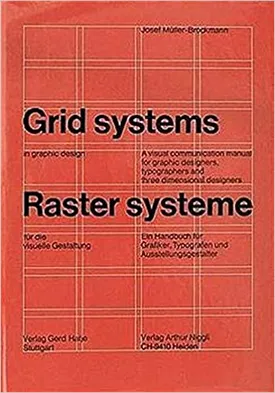Josef Müller-Brockmann
Josef Müller-Brockmann was a renowned Swiss graphic designer and teacher who helped define the genre of modern usage of typography, color, photography, and grid systems in Swiss design. A master of modern design, he is best known for his widely influential book "Grid Systems in Graphic Design".
Born in Zurich in 1914, Müller-Brockmann was only 15 years old when he started studying art, initially making a living by painting advertisements and book covers until beginning a design education at the Allgemeiner Gewerbeschule (now the Zurich University of Arts) in 1933. After graduating, he worked as an art director at the Department of Publicity, later working as an advertising manager for Schweizer Werbefachverband (the Swiss Advertising Union).
It wasn't until 1957, when he established his own graphic design agency in Zurich, that he devoted himself solely to corporate design, advertising, and poster design. Through his design agency, he developed and implemented modern design principles, advocating for simple grid-based designs and structured compositional layouts, which still hold relevance to present day.
Müller-Brockmann was a proponent of clear communication in his designs, believing that informational value should be prioritized above all else. He urged designers to remain mindful of the hierarchy of information and to ensure that each design project was organized by structure to ensure that the most important information was easily visible. Influenced by the international style of modernism, he used only sans-serif typefaces and structured grids, which he believed to be the most efficient systems for communicating effectively.
However, Müller-Brockmann also believed in the importance of aesthetics in design, and as such, embraced some aspects of the Bauhaus’s modernist style of design. He felt strongly that avant-garde design should be accompanied by aesthetic appreciation, allowing art to develop at the same rate as technology, and argued that art should be treated as an art form, while text, letters, and other typography should be treated as creative expressions in their own right.
Müller-Brockmann wrote several influential books and articles focusing on his theories of graphic design and was a professor of graphic design at the Schule für Gestaltung in Basel, Switzerland. He also taught workshops at various universities around the world and was an editor of the Productgraf magazine.
Müller-Brockmann's book "Grid Systems in Graphic Design" was published in 1961, becoming something of a bible for graphic designers in the decades following its release. In it, Müller-Brockmann outlined the different ways that grid design could be used to simplify and improve the readability of a design layout. He explained that the grid should be used to divide the page into subsidiary elements, to order and structure the text and imagery and to create an overall visual harmony for the artwork's elements.
Müller-Brockmann's enduring legacy can be found in modern day design principles, which have been shaped and defined by his works and teachings. Since his death in 1996, numerous books, awards, and exhibitions have been dedicated to his legacy, through which his work continues to be celebrated and recognized as an integral part of Swiss design as well as international graphic design. Through his contributions, he has elevated the medium and provided important frameworks for communication design and graphic designers worldwide.

